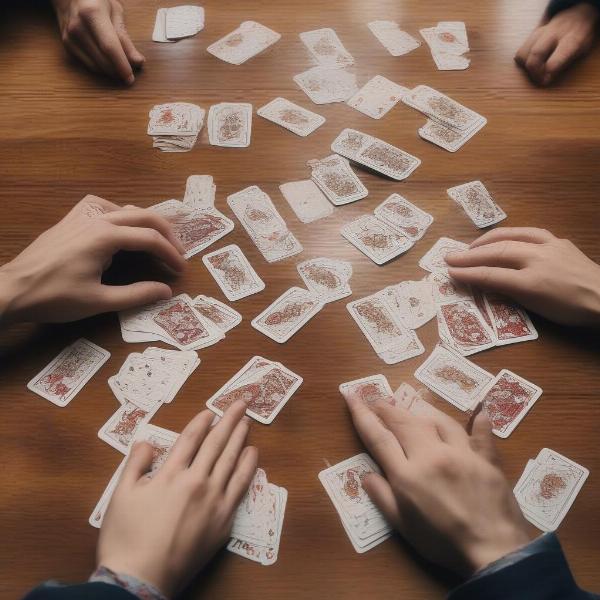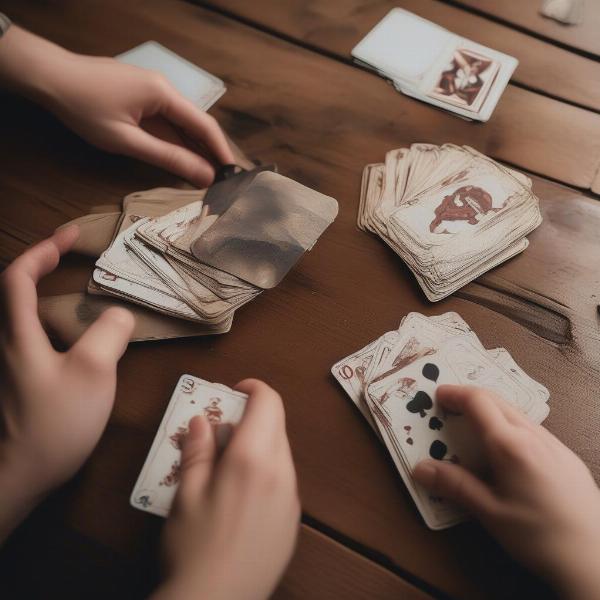Welcome to supremeduelist.blog, your premier source for all things gaming. Today, we delve into the exciting world of the war rules card game, a classic pastime that transcends generations. This guide will equip you with a thorough understanding of how to play, the core mechanics, and variations you might encounter. We aim to make you a master of this simple yet engaging card battle.
This article will explore the basic rules of War, analyze common house rules, and provide strategies to enhance your gameplay. Whether you’re a beginner or a seasoned player, this article will offer valuable insights into this enduring card game and its captivating appeal.
Understanding the Core War Card Game Rules
The war rules card game, at its most fundamental, is a game of pure chance. It’s typically played with a standard 52-card deck. The deck is evenly split between two players, each receiving 26 cards face down, creating their own draw pile. The aim of the game is simple: to win all of the cards. The game is also a good starting point for those looking to understand more complex card games.
The Basic Gameplay
To begin each round, both players simultaneously reveal the top card from their respective draw piles. The player who reveals the higher-ranking card wins both cards and adds them to the bottom of their personal pile. The rankings go from lowest to highest: 2, 3, 4, 5, 6, 7, 8, 9, 10, Jack, Queen, King, and Ace. Suits do not matter in this version of the game. This simple concept makes the game easy to learn and fast-paced.
 war card game setup
war card game setup
What Happens in the Event of a Tie?
A tie occurs when both players reveal cards of the same rank. This is where the ‘War’ aspect of the game really comes into play. Each player then places three cards face down and reveals a fourth card, and the highest ranking of these fourth cards determines who wins the “war” pile. If there’s another tie, the process is repeated until a player wins. This escalation adds an element of suspense and excitement to the game. It’s also a time when a larger part of the deck can change hands, turning the tide of the game. It’s important to have a grasp on these rules before exploring some advanced options such as egyptian war card game rules.
Variations and House Rules of the War Card Game
While the basic game of War is straightforward, many variations and house rules have evolved over time. These variations often add new twists and strategic elements to the game. From speed versions to modified tiebreakers, these additions cater to different preferences and skill levels.
Adding More Players
While the standard game is for two players, modifications exist to accommodate more players. These variations can range from each player having their own deck to each player getting a portion of a shared deck. This is perfect for family gatherings or game nights.
Speed War
Speed War is a faster-paced version of the game that has many iterations. In its simplest form, players can lay down cards faster than the standard version. There are multiple approaches to playing this, with the common element being a faster turnover rate of the deck. For example, both players can flip over multiple cards at once, making the game more intense and reducing downtime, or players can add more than one card to a battle when a war is called. Players are encouraged to try out a variation that matches their playstyle best.
Modified Tiebreakers
Some house rules tweak how ties are handled, changing how the “war” sequence unfolds. One variation is the introduction of a fixed number of face down cards, while another variation may only add one card to the pile. These tweaks alter the strategy and pace of the game, adding a new element of unpredictability. In some variants of the game, the player who called the War will forfeit their cards if they lose a battle. Exploring different versions will show how the game changes with even minor modifications to the standard procedure, as is the case with different interpretations of card game war rules pdf.
The “Low Card Wins” Variation
In this variant, the lowest-ranking card wins the hand, a complete reversal of the standard rules. This variation introduces a new layer of strategy, as players need to focus on trying to discard their high cards, instead of focusing on trying to get higher cards. This flip turns the game on its head and is a good variation to explore if you want a fresh take on the game.
Strategic Elements in the Game of War
While War is often considered a game of chance, strategic elements can influence the outcome. Awareness of the odds, keeping track of won cards, and understanding when to push for a “war” can turn the tide. Although the game lacks the complexity of a game like the star wars rebellion board game, it still provides moments of strategy when you take the game beyond the simple mechanics.
Card Counting and Tracking
A fundamental strategy, especially in longer games, is to be aware of which cards have been played. This can give players an advantage, particularly when determining the probability of winning a tie-breaker battle. It does not provide an absolute certainty, but it gives a player an upperhand that a more passive player may not have. Remembering which cards have been played can give clues about when your opponent is likely to have a higher ranking card.
Managing Your Pile
While there’s no hand management, the way players handle their won piles can impact the flow of the game. Some players prefer to shuffle these into their deck as soon as they get them, while others prefer to add it to the bottom of their deck to have it come out later. Being mindful about how you handle these piles may change the odds later in the game.
Understanding “War” Dynamics
Knowing when to push for war can be key. When both players have relatively similar decks, wars become very common. Managing them properly will be key to winning the game. While a game like the star wars the clone wars board game can require a lot of forethought, even a simple game like War has strategic implications.
Expert Quote:
“In War, while luck plays a big role, observing your opponent and the cards played can give you a small edge,” says Dr. Emily Carter, a game theory specialist. “Understanding probability is key to making the most of each battle.”
 playing the war card game
playing the war card game
Frequently Asked Questions about War
It’s common to have questions when learning a new game, and war rules card game is no exception. Here are some of the most common questions.
What if we run out of cards?
If a player runs out of cards during the game, they immediately lose the game. If both players run out of cards at the same time, it is considered a tie. Some players will choose to shuffle the used pile and continue playing, but it is up to house rule. If both players run out of cards during a “war”, that is considered a tie and players are encouraged to shuffle the cards and restart.
How long does a game of war typically last?
The length of the game can vary depending on the number of ties and the pace at which the players are putting cards out. It is usually a fast game, and most versions last around 10-20 minutes. This makes it an ideal choice for shorter gaming sessions.
Can children play the card game war?
Yes, the game is very child-friendly due to its simple rules and lack of complex strategies. It is a good starting point for children who are just starting to learn card games. Children as young as five can easily grasp the basic gameplay and have fun with it.
Expert Quote:
“War is one of the most accessible card games,” explains Michael Chen, a board game historian. “Its simple mechanics and quick playtime make it a go-to for players of all ages and skill levels.”
Conclusion
The war rules card game provides a perfect entry point for anyone looking to explore the world of card games. Its simplicity makes it easy to learn, while its endless variations keep it engaging. Whether you are a casual player or a serious strategist, War offers a simple but satisfying gaming experience, unlike a game like the star wars episode 1 monopoly game, which requires more time and investment.
At supremeduelist.blog, we aim to provide you with detailed analysis of the games you love to play, with expert insights that will elevate your understanding of the game. Now, equipped with all the rules and variations, go and enjoy a good match of war! Happy gaming!
Leave a Reply